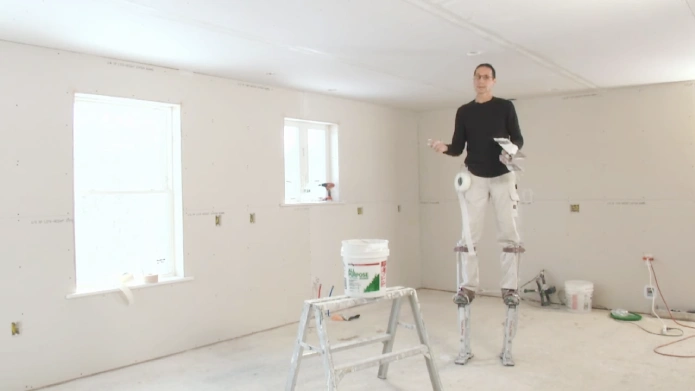Last Updated on March 5, 2023
Drywall stilts are the secret weapon of professional drywallers as they extend your reach and save you time. But if you’re just starting out in this line of work or exploring it as an upcoming career option, you may wonder: how hard is it to walk on those things?
With drywall stilts, you can take a lofty approach to your next project without any difficulty. They provide an even weight distribution across your feet and make you feel comfortable, but they require a focused mind to stay balanced.
Working on a high platform with no guardrails or safety net can be nerve-wracking. Not only does it pose risks from awkward landings, but tackling future jobs may become even more daunting due to the psychological impact.
But don’t worry. To stay safe and efficient, we’ve got some great tips for navigating these tall platforms with ease.
Is It Hard to Walk on Drywall Stilts: How Do It?

Walking on drywall stilts can be a challenge for new users. It takes practice and patience to learn how to traverse this unique form of transportation safely. By following the 4 steps outlined below, you’ll be able to get the hang of walking on drywall stilts in no time.
Step 1: Wear Appropriate Footwear:
It is essential to wear appropriate footwear when using drywall stilts. The best drywall stilts have height adjustability, firm foot support platforms, straps for ankle support, and lightweight construction for optimal performance.
Furthermore, the soles should have ample grip so that you don’t slip while moving on different surfaces. Cover up those knees and equip yourself with comfortable, reliable knee pads. Be sure to inspect your drywall stilts for any loose wing bolts before you start working.
Step 2: Secure Straps on Both your Foot and Leg:
Once you have chosen footwear that is suitable for stilt walking, it is important to secure adjustable straps both to your feet and legs properly. Securely fasten foot straps over footwear or shoes and leg straps over pants, making sure that they are not too tight but not loose enough to slip out, either.
Step 3: Sit On Raised Surface:
When getting accustomed to walking with the assistance of construction stilts, it helps to sit on a raised surface first to position your feet correctly. Place your feet onto the stilt so that they rest on top of it while bending the knee at a 90-degree angle before continuing with adjusting straps and ankle cuffs.
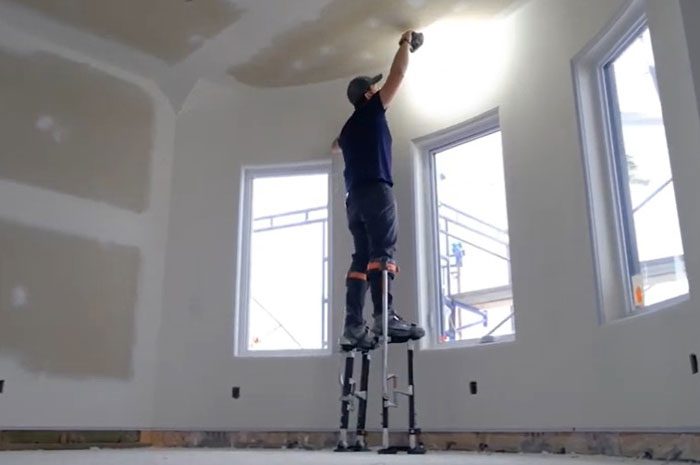
Step 4: Adjust Straps And Ankle Cuffs:
Once you are seated properly wearing drywall stilts, adjust all of the straps correctly so that they fit snugly but don’t restrict movement. This includes tightening both foot straps over work boots or shoes as well as securing leg straps over pants if needed.
It’s also important to ensure that the semi-circular knee brace sits below your knee joint and not above it in order to keep everything secure during movement.
Step 5: Stand Up And Walk:
Stand up slowly with support from either a wall or someone else, if available, until you get more comfortable with balancing yourself on drywall stilts unaided. At first, take a baby or small steps until you get used to it, and then gradually transition into taking larger strides until you feel confident about walking around safely wearing them.
Safety Considerations When Working with Drywall Stilts
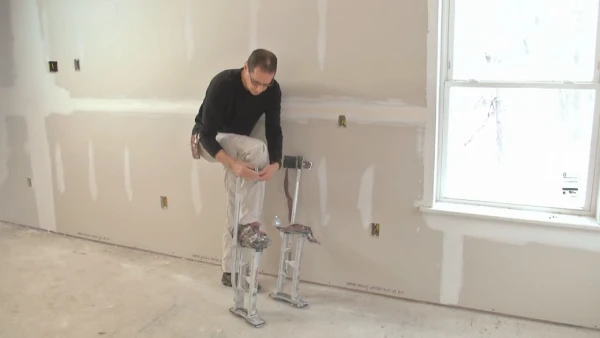
Safety is of utmost importance when working with drywall stilts, as they can contribute to falls, slips, and trips. Whether the task involves installing, measuring, or replacing drywall, it’s critical to understand the potential hazards of working with drywall stilts and take proper measures to reduce risks.
Common Hazards Associated with Unstable Surfaces:
Individuals working with drywall stilts need to be aware of the potential hazards associated with wet or unstable surfaces. Proper footwear should be chosen that will provide adequate traction and support on slippery surfaces.
Furthermore, special care needs to be taken when working at ceiling heights above 8 feet to prevent any falls or slips. Inspect the area for any obstructions that could create a hazardous situation before beginning work on a drywall project.
Moreover, workers should wear protective gear such as helmets and safety goggles in case of an accident.
Wearing Protective Gear:
Individuals should invest in quality harnesses, knee pads, straps, and belts in order to further reduce the risk of falls, slips, and trips while using drywall stilts. Before using drywall stilts, workers should get proper training from a qualified instructor, making sure they’re familiar with their safe use and all safety precautions.
Taking extra precautionary steps such as wearing gloves, may also help reduce risks related to cuts and scrapes from handling pieces of drywall material.
Potential Challenges When Using Drywall Stilts
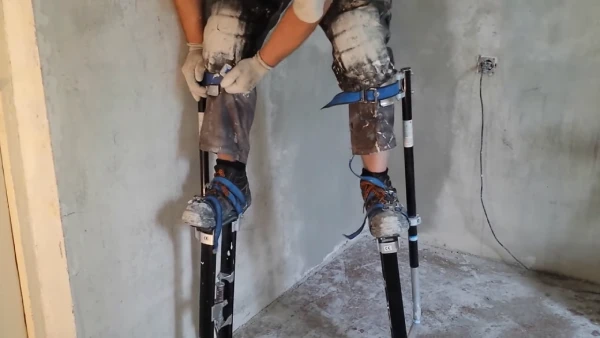
1. Physical fitness requirements can make it difficult to maneuver easily or comfortably on the stilts.
2. Uneven or slippery surfaces can make it difficult to maintain your balance.
3. Unfamiliar environments require more concentration to avoid collisions or falls
4. Working at heights can bring about increased stress or fear.
Why do Drywallers Use Stilts?

Drywallers have long used stilts as a cost-effective and efficient way to reach higher wall plates and joists when completing installation and finishing jobs.
Stilts provide a number of benefits, including increased reach, reduced risk of injury from unsafe heights, improved speed and accuracy of installation, as well as comfort and stability while on the job.
1. Height Advantage:
Working with stilts provides drywallers with an incredible height advantage. Whether working in basements or on ceilings, stilts allow drywallers to access areas that would otherwise be difficult or dangerous to reach without ladders or scaffolding.
This additional height also allows drywallers to work more accurately since they can easily adjust their position while remaining balanced and secure. The added height provided by stilts reduces the risk of injury due to slips or falls while working at high levels.
2. Makes the Job Easier:
Stilts make the job much easier for drywallers by providing fast installation and finishing processes.
With aluminum drywall stilts, it is simple for a drywaller to move around the job site without having to climb ladders or crawl on the floor. This makes it much quicker for them to finish a project than if they had to use traditional methods such as ladders or scaffolding.
Because of their lightweight design, it is easy for one person alone to carry and set up a pair of stilts quickly without assistance from another worker or additional materials.
3. Comfort:
Drywall stilts are important for providing ergonomic support while installing dry walls since they can help reduce stress on the legs, back, shoulders, and neck during long work days.
Stilts also offer stable support for balance when performing activities at high walls or ceilings, which further helps reduce potential injuries from falls or slips due to unsteady footing.
While staying balanced, stilts give you a wider range of motion in different directions, which helps you save time during installations that involve intricate angles.
4. Cost-effective Solution for Professional Use:
The spring stilts are generally cheaper than buying scaffolding or other alternatives when needing to reach higher areas during professional jobs. Since they’re lightweight and easy to move around, they’re even more convenient than heavy scaffolding that needs assembly every time.
Purchasing a quality pair of stilts can last many years if maintained properly so you can get an excellent return on your investment over time.
Is It Hard to Balance On Drywall Stilts?
It is not hard or difficult to balance on drywall stilts if you have the right size stilts and know how to use them properly.
When wearing stilts, your center of gravity moves up, meaning that it takes more effort for you to stay upright. This does not mean it is necessarily difficult, with a bit of practice, using drywall stilts becomes second nature.

To begin with, it requires good coordination between the user’s lower body and upper body. When first starting out, having someone alongside you to help spot can be useful in keeping your balance and providing guidance as you learn the technique.
Is Walking On Drywall Stilts More Efficient?
Yes, walking on drywall stilts can significantly increase efficiency when completing projects that involve walls higher than 10 feet. By using drywall stilts, a worker can walk up and down walls quickly without needing to set up ladders or scaffolding to reach those heights.
This greatly reduces labor time and costs associated with projects requiring high walls because workers are able to complete the tasks faster while being more secure and stable on the wall than they would be by climbing ladders or scaffolding.
Are Drywall Stilts Allowed by OSHA?
Yes, OSHA (Occupational Safety and Health Administration) has approved the use of drywall stilts for construction purposes in both residential and commercial settings as long as safety guidelines are followed.
Worker safety guidelines include wearing helmets, knee pads, gloves, eye protection, and maintaining three points of contact with the wall while walking on drywall stilts.
What Do You Call Someone Who Walks On Drywall Stilts?
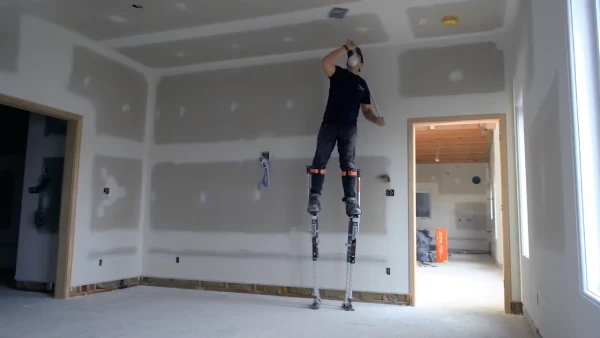
Someone who walks or operates drywall stilt equipment is usually referred to as either a ‘drywallwalker’ or a ‘stilt walker’. This term is used widely in industries such as construction where workers may often need extra stability when reaching higher walls without resorting to ladders or scaffolding systems.
Are Drywall Hand held Stilts Hard to Learn?
No, drywall hand held stilts are actually quite easy to learn how to use. They require minimal practice and the right safety equipment such as gloves, protective eyewear and sturdy shoes for good traction on slippery surfaces.
Even novice users can get started on their projects quickly and safely with detailed instructions provided by manufacturers. Additionally, there are a number of online tutorials available which can be very helpful when getting started with drywall stilt use.
How Tall Do Drywall Stilts Go?
The tallest size available is extra tall at 64 inches, although other sizes may be custom-made upon request if necessary.
But drywall stilts come in three standard sizes: general tall (15” – 23”), standard tall (24” – 40”), and extra tall (48” – 64”). Additionally, adjustable feet may also be added to certain models allowing the user to adjust the elevation in order to reach higher heights more easily.
What Is the Weight Limit for Drywall Stilts?

Drywall stilt weight limit is typically 225 pounds. This is a safe weight capacity that will accommodate most users, regardless of their height or size. Several manufacturers make stilts made of strong materials like aluminum alloy and steel that can support heavier weights.
What Happens If You Fall in Drywall Stilts?
Falls from higher heights can lead to fractures, broken bones, and even head trauma. Moreover, falling on drywall stilts can be very dangerous and even potentially deadly to the drywaller.
Use Drywall Stilts Safely for Maximum Reach and Balance
If you’re looking to take your stilt walking skills to new heights, the key is taking all the right safety measures. With a bit of preparation and proper use, you’ll be hopping on drywall stilts like an expert in no time.
At first, it may seem like a strange experience to be on drywall stilts, balancing your body while wearing such tall tools. But trust us, once you get the hang of it those awkward feelings will melt away quickly, and soon enough, walking around with them becomes much easier.
Keep in mind that although drywall stilts offer many benefits, such as increased reach and improved balance, there is still potential danger if you fall off of them, so always make sure to stay safe when using this tool.
